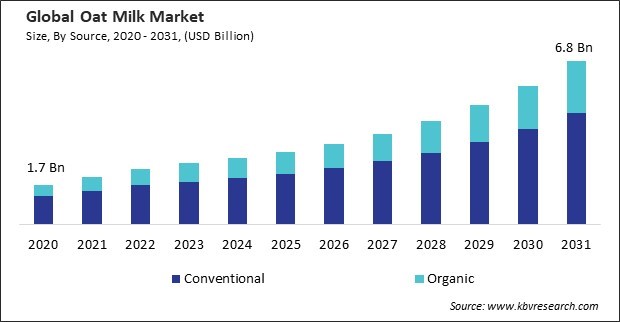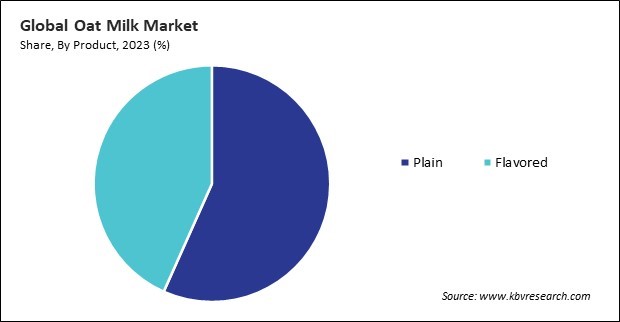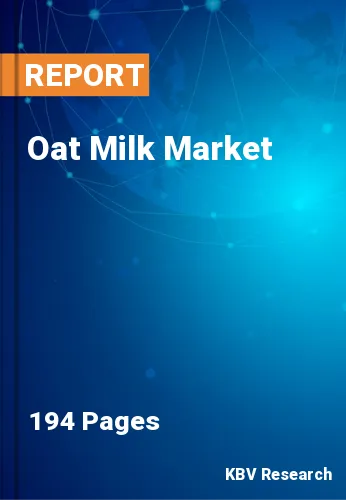“Global Oat Milk Market to reach a market value of 6.8 Billion by 2031 growing at a CAGR of 13.7%”
The Global Oat Milk Market size is expected to reach $6.8 billion by 2031, rising at a market growth of 13.7% CAGR during the forecast period. In the year 2023, the market attained a volume of 536.34 kilo tonnes, experiencing a growth of 12.4% (2020-2023).
The growth of the oat milk market in India is significantly influenced by the rising Gross National Disposable Income (GNDI), which the Ministry of Statistics & Programme Implementation projects to be ₹236.07 lakh crore for 2021–2022. This marks a substantial increase from the ₹201.15 lakh crore estimated for 2020-21, reflecting a robust growth rate of 17.4%. This increase in disposable income is pivotal for several reasons, as it affects consumer spending patterns and the overall demand for health-oriented products like oat milk. Hence, in 2023, the Asia Pacific region generated nearly 1/4th revenue share in the market. In terms of volume, 375.92 kilo tonnes of oat milk is expected to be utilized by the year 2031. Oat milk’s appeal lies in its creamy texture and versatility, making it suitable for various applications in beverages and food products. The rise of veganism and vegetarianism, especially among younger demographics, has further fuelled the demand for oat milk in countries such as Australia, New Zealand, and parts of Southeast Asia.

Growing concerns about climate change and environmental sustainability drive consumers toward plant-based diets. Oat milk has a lower environmental impact than dairy milk, as it requires less water and produces fewer greenhouse gas emissions. The ethical considerations surrounding animal welfare prompt many consumers to adopt vegan lifestyles. Oat milk aligns with these values as it is a plant-based product free from animal cruelty. Additionally, the rise of plant-based diets, including veganism and flexitarianism, has increased the demand for dairy alternatives. Oat milk suits those looking to reduce or eliminate animal products from their diets. These products appeal to busy consumers seeking nutritious, portable options. In conclusion, rising consumer health consciousness and increased demand for oat milk in food and beverage applications propel the market's growth.
However, many oat milk producers are small to medium-sized companies that may not benefit from economies of scale. This lack of scale can result in higher production costs per unit, making it difficult to compete with larger dairy or alternative milk producers that can spread their costs across higher volumes. The initial costs can be prohibitive for smaller brands looking to scale up production to meet growing demand. These barriers can limit their ability to enter or expand the market effectively. This price sensitivity can pressure oat milk producers to lower their prices, impacting profitability. Hence, higher production costs and pricing pressure hamper the market's growth.
On the basis of packaging, the market is segmented into cartons, bottle, and other packaging. In 2023, the cartons segment attained 46% revenue share in the market. In terms of volume, 512.19 kilo tonnes of carton packaged oat milk is expected to be utilized by the year 2031. Cartons are widely favoured for their environmental benefits, as they are typically made from renewable resources such as paperboard and are fully recyclable. This aligns with the growing consumer awareness and demand for sustainable packaging solutions driven by increasing environmental concerns.
By product, the market is divided into flavored and plain. The flavored segment procured 43% revenue share in the market in 2023. In terms of volume, it is expected that 521.64 kilo tonnes of Flavored oat milk would be utilized by the year 2031. This segment caters to consumers who seek more variety and enhanced taste experiences, with options like vanilla, chocolate, and berry. The popularity of flavoured oat milk is driven by the increasing demand for ready-to-drink beverages that provide both nutrition and a pleasant taste. These flavoured options appeal to a wide range of taste preferences and dietary needs, making them a popular choice among consumers looking for both convenience and flavour in their plant-based milk.

Based on source, the market is divided into conventional and organic. The organic segment attained 30% revenue share in the market in 2023. In terms of volume, 260.66 kilo tonnes of Organic oat mils is expected to be utilized by the year 2031. Rising consumer awareness about health and environmental issues has fuelled the demand for organic products, including oat milk. Organic oat milk appeals to consumers willing to pay a premium for healthier and more environmentally sustainable products. This segment’s growth is also supported by the increasing availability of organic options in supermarkets and health food stores and major brands' expansion of organic product lines.
On the basis of distribution channel, the market is segmented into supermarkets & hypermarkets, convenience stores, online retail, and others. The convenience stores segment held 28% revenue share in the market in 2023. In terms of volume, 330.46 kilo tonnes of oat milk is expected to be sold through convenience stores by the year 2031. This growth can be attributed to the increasing demand for quick and convenient shopping experiences, particularly among urban consumers and busy professionals. Convenience stores are strategically located and offer a variety of oat milk products, catering to consumers who may not have the time or inclination to visit larger supermarkets.
Free Valuable Insights: Global Oat Milk Market size to reach USD 6.8 Billion by 2031
Region-wise, the market is analyzed across North America, Europe, Asia Pacific, and LAMEA. The Europe region witnessed 39% revenue share in the oat milk market in 2023. In terms of volume, 414.56 kilo tonnes of oat milk would be utilized in this region by the year 2031.This can be attributed to several key factors driving the region's consumer demand for oat milk. Increasing health consciousness among consumers has led to a shift away from traditional dairy products toward plant-based alternatives. Oat milk, recognized for its creamy texture and nutritional benefits, has become a favoured choice among those seeking lactose-free and dairy-free options.
| Report Attribute | Details |
|---|---|
| Market size value in 2023 | USD 2.6 Billion |
| Market size forecast in 2031 | USD 6.8 Billion |
| Base Year | 2023 |
| Historical Period | 2020 to 2022 |
| Forecast Period | 2024 to 2031 |
| Revenue Growth Rate | CAGR of 13.7% from 2024 to 2031 |
| Quantitative Data | Volume in Kilo Tonnes, Revenue in USD Billion, and CAGR from 2020 to 2031 |
| Number of Pages | 357 |
| Tables | 850 |
| Report coverage | Market Trends, Revenue Estimation and Forecast, Segmentation Analysis, Regional and Country Breakdown, Porter’s 5 Forces Analysis, Company Profiling, Companies Strategic Developments, SWOT Analysis, Winning Imperatives |
| Segments covered | Source, Product, Distribution Channel, Packaging, Region |
| Country scope |
|
| Companies Included | The Hain Celestial Group, Inc., PepsiCo, Inc., Danone S.A., Campbell Soup Company, Califia Farms LLC, Rise Brewing Co., Thrive Foods, The Coca Cola Company, HP Hood LLC, Chobani LLC |
By Source (Volume, Kilo Tonnes, USD Billion, 2020-2031)
By Product (Volume, Kilo Tonnes, USD Billion, 2020-2031)
By Distribution Channel (Volume, Kilo Tonnes, USD Billion, 2020-2031)
By Packaging (Volume, Kilo Tonnes, USD Billion, 2020-2031)
By Geography (Volume, Kilo Tonnes, USD Billion, 2020-2031)
This Market size is expected to reach $6.8 billion by 2031.
Rising Health Consciousness Among Consumers and The Shift Towards Veganism are driving the Market in coming years, however, Limited Shelf Life Compared to Traditional Dairy Products restraints the growth of the Market.
The Hain Celestial Group, Inc., PepsiCo, Inc., Danone S.A., Campbell Soup Company, Califia Farms LLC, Rise Brewing Co., Thrive Foods, The Coca Cola Company, HP Hood LLC, Chobani LLC
In the year 2023, the market attained a volume of 536.34 kilo tonnes, experiencing a growth of 12.4% (2020-2023).
The Conventional segment is leading the Market by Source in 2023; thereby, achieving a market value of $4.7 billion by 2031.
The Europe region dominated the Market by Region in 2023; thereby, achieving a market value of $2.5 billion by 2031.
Our team of dedicated experts can provide you with attractive expansion opportunities for your business.

 Drivers
Drivers
 Restraints
Restraints
 Opportunities
Opportunities
 Challenges
Challenges
